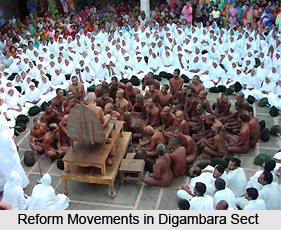 Several reform movements were launched by many leaders of different Jain denominations. Among the reform movements that took place in the Digambara sect, the `Das Pujadhikara Andolana` i.e., `the Dasas` Right to Worship Movement` is of much importance. The `Dasas` are persons who belong to the `Dasa` divisions of Jain castes. `Visa` and `Dasa` as names of divisions of castes is common amongst the Jain castes like
Osavala, Hummada, Agarwala, Porvada in northern and western India. The term `Visa` means `twenty in the score` i.e. pure, and `Dasa` signifies `ten in the score`, i.e., half-pure.
Several reform movements were launched by many leaders of different Jain denominations. Among the reform movements that took place in the Digambara sect, the `Das Pujadhikara Andolana` i.e., `the Dasas` Right to Worship Movement` is of much importance. The `Dasas` are persons who belong to the `Dasa` divisions of Jain castes. `Visa` and `Dasa` as names of divisions of castes is common amongst the Jain castes like
Osavala, Hummada, Agarwala, Porvada in northern and western India. The term `Visa` means `twenty in the score` i.e. pure, and `Dasa` signifies `ten in the score`, i.e., half-pure.
In order of social respectability the Jain castes like Visa and Dasa divisions are treated in a descending order. For marital purposes these caste divisions are regarded as heterogamous.
According to the order the Dasa persons were regarded lower in caste system or social status hence many social restrictions were imposed on them like inter- dining and inter-marriage relations. Apart from these social restrictions many religious disabilities were also enforced on them which restricted the people belonging to Dasa caste from performing many religious rites. It also forbade them from performing puja or entering the temple. Such religious discriminations and social injustice was vehemently opposed by the leading intellectuals and was strongly resisted by the Dasa persons amongst the Digambara Jains.
The `Das Pujadhikara Andolana` was initiated by Pandit Gopaladasaji Baraiyya of Varanasi He declared in unambiguous terms that `in accordance with the liberal tenets of Jainism the Dasas have the equal right to worship like the non-Dasa persons`. This movement was opposed by rich persons. Thus after a prolonged controversy, the matter was taken to the court. However, the decision of the court went against the Dasa community. It said that Dasas had no right to worship as there is no custom or practice in prevalence to that effect. The decision of the court gave rise to widespread disquiet between the Visa and Dasa sections for a long time. As a result many Dasa persons left the Digambara denomination and joined the Swetambaradenomination.
The All India Digambar Jain Parishad, located in Delhi later took up the movement. It is the national representative organisation of the Digamabara Jains. It was the untiring efforts of the organisation that led to a change in the circumstances. The organisation ascertained a respectable position and thus they began to enjoy in full measure their right to worship in Jain temples. The Dasas even built temples from their own funds for common use.
At the beginning of the twentieth century the second prominent movement of a socio-religious nature was launched by the Digamabara Jains. The movement was known as `shastra-mudrana Virodhi Andolana` i.e. the Anti-Scripture Printing Movement. The movement prevented the Shastras, the sacred literature preserved in manuscript form, from being printed and published in text form. Many intellectual and social leaders from north India like Babu Suraja-bhanaji, Babu Jyotiprasadaji Jain and Pandit Chandrasen Vaidya had implored for the printing and publication of ancient Holy Scriptures on all subjects in text form. According to them this would help the general public to access information. It would also prove to be useful in guiding their social and religious practices.
This practise was vehemently opposed by the orthodox sections as they felt that printing the Holy Scriptures in text form was an anti-religious act. According to them it was a sin to touch a printed religious text and hence they forbid keeping the printed religious texts in temples and also enforced a social and religious boycott on the publishers of such texts. This opposition could not stand for long time because with change in time leaders of all other religions began making use of the printing machine. The opposition failed and the printing of ritualistic literature and sacred texts geared momentum. Separate Jain scripture publishing concerns were founded and publication of many texts under the `Jain Sacred Literature Series` was undertaken. The commencement of this publication activity on a large scale greatly helped in ushering social reform amongst Jains in different parts of India.



















